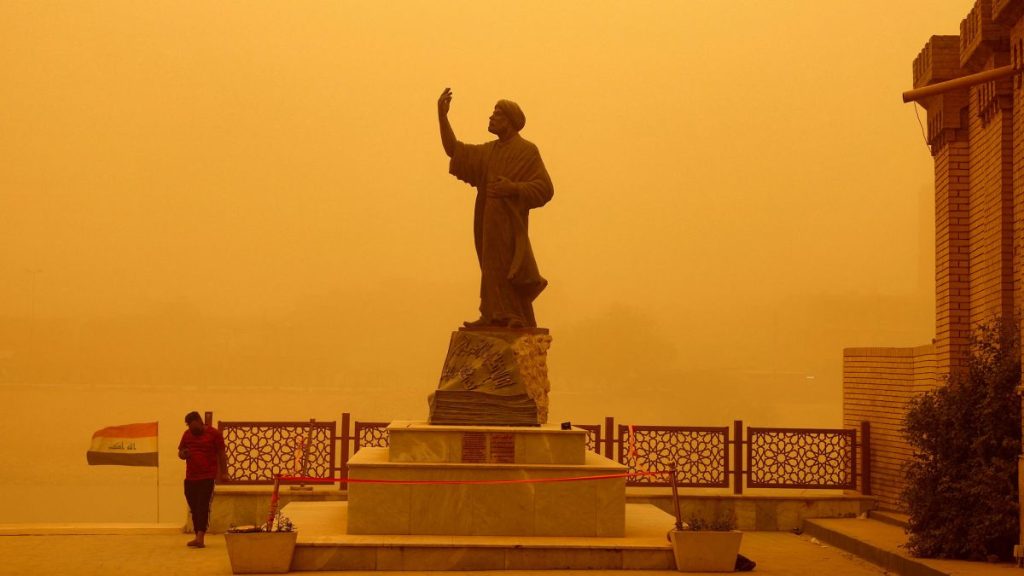The Middle East’s $13 billion sandstorm problem is about to get worse

Thousands of people in the Middle East flooded hospitals, unable to breathe properly. In Syria, medical units stockpiled canisters of oxygen. Businesses and schools were shut in Baghdad, while Tehran suspended flights and Kuwait halted maritime traffic. Sandstorms While sandstorms are typical this time of year, they are now occurring with unprecedented frequency, experts say. Iraq has been especially hard hit, with storms occurring on an almost weekly basis this spring. According to Ali Attiya, a professor of atmospheric science at Mustansiriyah University in Baghdad, a typical spring would see about one to three storms per month, but at least nine major storms have descended on the country since April, with more expected. An Iraqi official warned this year that the country is now facing an average of 272 “dust days” a year, “Armed conflict has had a huge impact on environment, on governance and on society,” said Igor Malgrati, the Middle East water and habitat adviser for the International Committee of the Red Cross (ICRC). The effects of climate change will only intensify these problems. Temperatures in the Middle East are rising twice as fast as the global average and climate models predict a decrease in precipitation over some key parts of the region. But part of the problem could also originate much further afield. Diana Francis, the head of the Environmental and Geophysical Sciences lab at Khalifa University in the UAE, found that a major 2015 dust storm that impacted Iraq and parts of the Arabian Peninsula was formed due to changes in the polar region. “Melting ice in Meanwhile, Saudi Arabia has committed to plant 10 billion trees in the country and another 40 billion in the region to fight sandstorms and desertification. The country is home to the world’s largest sand desert. In 2016, the UAE’s Masdar Institute launched a high-tech dust forecasting system that countries in the Middle East could use to better prepare for major storms. But experts argue more needs to be done and if countries don’t act soon, the consequences for the region will be devastating. “They run the risk of these summer dust storm seasons becoming the norm,” warned Mahmoud. “In the long term, if that level of frequency and magnitude persists, you are looking at serious public health issues in respiratory illnesses and deaths and huge economic costs.”The digestEighty people trapped in rubble of Iran building collapse that killed 11 Iranian judicial authorities investigating a building collapse that killed at least 11 people have detained the mayor of the southwestern city of Abadan and nine others, state media reported on Tuesday. Background: The 10-storey residential and commercial building partly collapsed on Monday, trapping at least 80 people under the rubble, according to state TV. Authorities said other sections of the building may collapse and called on people not to gather near the site. Why it matters: The disaster prompted accusations that warnings about poor safety standards and the building’s weak structure had been ignored. In 2017, 20 firefighters were killed when a 17-storey commercial building in the capital Tehran collapsed as they tried to put out a blaze. Taliban to sign pact with UAE on running Afghan airports The Taliban will sign an agreement with the United Arab Emirates on operating airports in Afghanistan, the group’s Acting Deputy Prime Minister Mullah Abdul Ghani Baradar said on Tuesday, after months of talks with the UAE, Turkey and Qatar. Background: Qatar and Turkey had already sent temporary technical teams to help airport operations and security after the Taliban took over in August last year as foreign forces withdrew. Baradar said his administration was renewing an airport ground handling agreement with the UAE. Why it matters: The airport talks have demonstrated how countries are seeking to assert their influence in Afghanistan even as the hardline Islamist group largely remains an international pariah and its government not formally recognized by any nation. Qatar and the UAE have had strained relations for years as they compete for regional influence. Saudi foreign minister says some progress in talks with Iran Saudi Arabia’s Foreign Minister Prince Faisal bin Farhan said on Tuesday that there had been some progress in talks with Iran but “not enough,” and that the kingdom’s hands remain outstretched to Tehran. Background: Saudi Arabia and Iran, which are locked in proxy conflicts across the Middle East, have held five rounds of talks hosted by Baghdad. “We continue to encourage our neighbors in Iran to lean into what can be a very, very important sea change in our region,” bin Farhan said, adding that a “new era of cooperation” could deliver benefits for all. Why it matters: A resolution of differences between the two Middle East powers could significantly ease tensions in countries like Yemen, Lebanon and others where they have been engaged in proxy conflicts. CNN investigates An investigation by CNN offers new evidence that there was no active combat near Al Jazeera journalist Shireen Abu Akleh in the moments before she was killed by a shot to the head in the Israeli-occupied West Bank on May 11. In a preliminary inquiry, the army said the Palestinian-American journalist was possibly hit either by indiscriminate Palestinian gunfire, or by an Israeli sniper positioned about 200 meters (about 656 feet) away in an exchange of fire with Palestinian gunmen. But videos obtained by CNN, corroborated by testimony from eight eyewitnesses, a forensic audio analyst and an explosive weapons expert, suggest that Abu Akleh was shot dead in a targeted attack by Israeli forces. Here are the key findings: A direct line of sight: Of the 11 videos obtained by CNN, two show the scene when Abu Akleh was killed. One video shows a direct line of sight to an Israeli armored vehicle parked 200 meters away, which has an opening for a sniper. The footage shows that in the minutes leading up to the shooting, there was no active combat in the area. The video also shows the moment that Abu Akleh and other reporters were fired on from the direction of the Israeli convoy. Targeted shots: The forensic audio analyst who assessed the footage estimated that the gunman who shot Abu Akleh was 177-197 meters away. The Israeli military has said a soldier was positioned in a vehicle the same distance from her. The explosive weapons expert who assessed the same footage, said the gunfire was consistent with assault rifles used by Israeli soldiers, and that the bullet marks on the tree behind Abu Akleh indicated that she was killed in targeted shots. He said that at 200 meters away, there was “no chance” that random or stray fire would result in such a tight configuration of strike marks, which contradicts the Israeli military’s suggestion that Abu Akleh could have been hit by Palestinian gunmen firing indiscriminate gunfire. Palestinian gunmen out of range: Israeli Prime Minister Naftali Bennett’s office shared footage of Palestinian gunmen firing haphazardly down alleyways in different parts of Jenin, originally claiming that the footage suggested “Palestinian terrorists were the ones who shot the journalist.” CNN geolocated the videos to the south of the camp, more than 300 meters away from Abu Akleh. The coordinates of the two locations demonstrate that the shooting in the videos couldn’t be the same volley of gunfire that hit the journalist. Israeli snipers nearby: Eight eyewitnesses told CNN that Israeli forces positioned about 200 meters away on the same street fired on Abu Akleh and other reporters in a targeted attack. The eyewitnesses — five journalists and three local Jenin residents — said they saw snipers in the Israeli convoy, aiming rifles out of the vehicles toward the journalists. The eyewitnesses said that the journalists had been visible to the Israeli soldiers for about 10 minutes before the gunfire began. In a statement emailed to CNN, the Israel Defense Forces said it was conducting an investigation into the killing, adding that “assertions regarding the source of the fire that killed Ms. Abu Akleh must be carefully made and backed by hard evidence. This is what the IDF is striving to achieve.” By Eliza MackintoshAround the region







